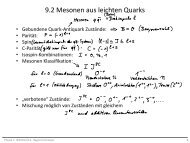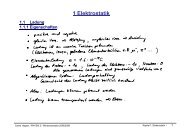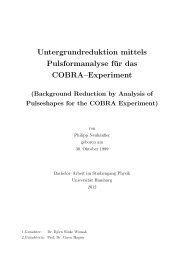Setup of a Drift Tube Muon Tracker and Calibration of Muon ...
Setup of a Drift Tube Muon Tracker and Calibration of Muon ...
Setup of a Drift Tube Muon Tracker and Calibration of Muon ...
You also want an ePaper? Increase the reach of your titles
YUMPU automatically turns print PDFs into web optimized ePapers that Google loves.
essential for vetoing these events.Cosmic muons created in the atmosphere have the ability to penetrate the Earthto significant depths. They are hard to shield <strong>and</strong> a disturbance to measurementswith most particle detectors. Placing the experiment underground helps to reducethe muon flux. However, even at a depth <strong>of</strong> a few thous<strong>and</strong> meters water equivalentcosmic muons still cannot be neglected. It is thus <strong>of</strong> importance to effectively tagthese muons to be able to veto their induced signals.To veto events from cosmogenic induced nuclei, the intersection <strong>of</strong> a cylinderaround the incident muon track <strong>and</strong> a sphere around the position <strong>of</strong> the capture <strong>of</strong>the knocked out neutron are taken <strong>of</strong>f the fiducial volume for a few half-lives <strong>of</strong> the11 C. A good resolution <strong>of</strong> the muon tracking thus is a key feature to prevent largefractions <strong>of</strong> the detector being blinded by this method. In Borexino, muon tracks arereconstructed by investigating the arrival time patterns at the PMTs. For a precisedetermination <strong>of</strong> the tracking resolution, the true muon track coordinates have tobe known.The compact muon tracker (CMT) presented in this work is capable <strong>of</strong> a threedimensional reconstruction <strong>of</strong> muon tracks with a spatial resolution <strong>of</strong> better than300ñm <strong>and</strong> an angular resolution <strong>of</strong> approximately 5 mrad. It is based on the drifttube technology developed for the Precision <strong>Tracker</strong> (PT) <strong>of</strong> the OPERA experiment.Whereas the PT only reconstructs 2D projections <strong>of</strong> muon tracks, the CMT has beenmodified so that a three dimensional tracking is possible. After a commissioning inHamburg it is now operated at the Borexino experiment at the LNGS undergroundlaboratory in the Abruzzo region in Italy. Although the CMT only covers a smallfraction <strong>of</strong> the Borexino detector, muon tracks reconstructed in the detector canbe used as a reference sample for the internal Borexino muon tracking. Thus, theCMT data can be used to determine the resolution <strong>of</strong> the internal Borexino muontracking. Comparing the tracks as reconstructed by the CMT with high precisionto the Borexino reconstruction can help to identify possible systematic errors <strong>of</strong> thelatter, <strong>and</strong> to improve its performance <strong>and</strong> hence the 11 C tagging.Within this thesis, the setup <strong>and</strong> commissioning <strong>of</strong> the CMT were performed<strong>and</strong> are described here. Its application to the Borexino experiment is presented <strong>and</strong>the resolution <strong>of</strong> the Borexino muon tracking is determined.Following the introduction, Chapter 2 <strong>of</strong> this work deals with the physics <strong>of</strong>neutrinos. After a brief overview <strong>of</strong> the history <strong>of</strong> neutrino physics in Section 2.1,the basics <strong>of</strong> neutrino oscillations are presented. An emphasis on solar neutrinos inparticular is given in Section 2.3, followed by a look at other neutrino sources <strong>and</strong>open questions in neutrino physics.The general setup <strong>of</strong> the CMT is described in Chapter 3. After an introductionto the working principle <strong>of</strong> drift tubes, the setup <strong>of</strong> the individual components suchas the drift tube modules, the gas supply, <strong>and</strong> the electronics is described. This isfollowed by a description <strong>of</strong> the data taking procedure. The CMT data are processedwith the s<strong>of</strong>tware package cmtrack which was developed within this thesis <strong>and</strong> isthen introduced. The reconstruction algorithms are described in detail. Finally, thecalibration <strong>and</strong> alignment <strong>of</strong> the detector is introduced <strong>and</strong> the first commissioning<strong>of</strong> the detector in Hamburg is presented.Chapter 4 gives an overview <strong>of</strong> the Borexino experiment. The detection methodfor neutrinos in liquid scintillators is described <strong>and</strong> the general setup <strong>of</strong> the Borexino2





